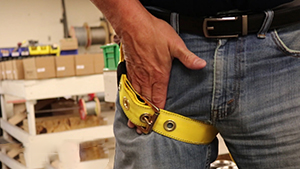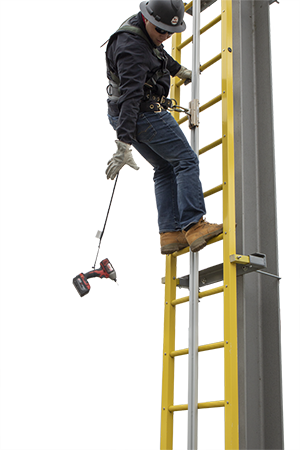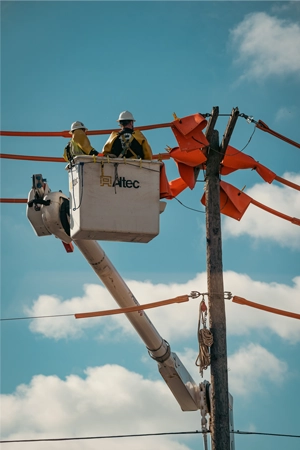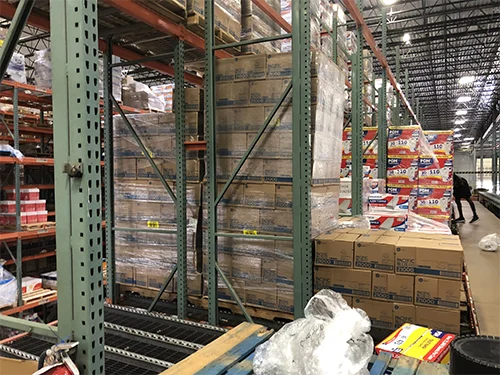Your cart is currently empty!
11 Hidden Fall Hazards
Hidden Fall Hazards And How to Avoid Them
Fall protection is a critical aspect of workplace safety, but even the best safety plans can’t account for every potential hazard. That’s why it’s important to be aware of the hidden fall protection hazards that could put your workers at risk. These hazards are not always obvious, and they can be difficult to detect and prevent. In this blog post, we’ll take a closer look at some of the most common hidden fall protection hazards and what you can do to keep your workers safe.
1. Improper Use of Full Body Harnesses

First and foremost, it’s important to understand that fall protection is only as effective as the person wearing it. In order for fall protection to truly protect you, you need to be properly trained on how to use it and you need to use it correctly. This means not only wearing the right type of fall protection for the job, but also making sure that it’s properly adjusted and secured. If a full body harness is not worn correctly, it can become entangled in equipment or other objects, which can increase the risk of a fall or cause injury. “It is easy to overlook, but one of the most common fall protection hazards I see is improperly wearing a full body harness.” Says FrenchCreek’s Director of Training Blaine Pettit.
2. Struck By Falling Object 
One hidden hazard that often goes overlooked is the risk of being struck by a falling object. Even if you’re wearing fall protection and working on a secure platform, a falling object can still hit you and cause serious injury or death. To protect yourself, make sure that you’re always wearing a hard hat and that you’re aware of what’s going on around you. If you see something falling, get out of the way as quickly as possible. Likewise, falling tools can pose a serious danger to workers below. Gravity can generate fatal impact forces even with the smallest of tools. We recommend using a tool lanyard that can eliminate the hazard of dropped objects when working from heights. FrenchCreek tool lanyards fit various shapes and sizes of tools.
3. Caught In Or Between Equipment
Another hidden hazard is the risk of getting caught in or between equipment. This can happen if you’re working near large machinery or if you’re working in a confined space. To protect yourself, make sure that you’re aware of the equipment you’re working around and that you’re wearing the appropriate personal protective equipment (PPE) for the job. If you’re working in a confined space, make sure that someone is monitoring you from outside and that you have a means of communication with them.
4. Skylights
A common but often overlooked fall hazard is skylights. It is easy to identify a hole on the ground level, but many times skylights give workers a false sense of security. Skylights can pose fall hazards if they are not properly maintained or if safety measures are not in place. For example, if a skylight is cracked or damaged, it may not be able to support the weight of a person and could give way, resulting in a fall. Additionally, if there is no guardrail or other protective barrier around the skylight, a person could accidentally step off the edge and fall through the skylight. To prevent these hazards, it is important to regularly inspect skylights for damage, repair any cracks or other issues, and install guardrails or other safety measures around the skylight as needed. Additionally, when working near skylights, it is important to use fall protection equipment such as harnesses and lanyards.
5. Unloading Or Working On Top Of Trailers
Fall protection is generally required when working at heights, including when unloading trailers of semi-trucks. According to OSHA (Occupational Safety and Health Administration) standards, employers are required to provide fall protection when an employee is working at a height of four feet or more above a lower level. This includes when unloading trailers of semi trucks, as the trailer bed is typically at a height of four feet or more above the ground. Employers are required to provide fall protection systems, such as guardrails or personal fall arrest systems when working on top of trailers. Workers can be injured if the load they are unloading is not properly secured and shifts while they are on top of the trailer. In addition, weather conditions, such as high winds or rain, make it difficult to maintain their balance. If a fall arrest system is used, it should include a full body harness and a lanyard that is anchored to the vehicle or a secure point.
6. Articulated Boom Truck 
There are several hidden fall hazards that can be present when using an articulated boom truck. One hazard is the failure of equipment such as the boom or outriggers, which can cause the truck to become unstable and lead to a fall. Another hazard is the lack of proper training or knowledge of how to safely operate the truck, which can lead to improper use of the equipment and increase the risk of falls. Additionally, some fall hazards may not be immediately obvious, such as the condition of the surface on which the truck is operating or the potential for a power line to be in close proximity. Weather conditions such as high winds or rain can also pose a hidden fall hazard as they can make it difficult to maintain balance while on the articulated boom truck. It is important for employers to be aware of these hidden fall hazards and to take appropriate measures to address them, such as regular equipment inspections, proper training, and providing fall protection equipment to workers.
7. Pallet Gates
Pallet gates can be fall hazards because they are often used to access the mezzanine level or the elevated platforms in a warehouse or distribution center. These gates may be located at the edge of the mezzanine or platform, and if not properly secured, they can swing open unexpectedly. This can create a gap or opening in the floor, which can increase the risk of falls. Also, if the gate is not properly maintained it can be worn and unstable, which increases the risk of falls. Another hazard is when the pallet gate is left open and not secured, it can create a tripping hazard for workers who might not be aware of it. Additionally, the use of pallet gates can create a risk of falls if workers are not properly trained on how to safely use them, such as the proper way to open, close, or lock the gate or if they are not aware of the hazards associated with them. It is important for employers to be aware of these hazards and to take appropriate measures to address them, such as proper training, regular equipment inspections, and ensuring that the gates are properly secured and maintained.
8. Mezzanines 
In addition to pallet gates, another hidden fall hazard is the lack of clear markings of the different levels of the mezzanines. Mezzanines are often used for storage, and if the loads are not properly secured it can increase the risk of falls. Workers can also fall if the access to the mezzanine is not safe, such as if a ladder or staircase is not properly secured or maintained. It is important for employers to be aware of these hidden fall hazards and to take appropriate measures to address them, such as regular equipment inspections, proper training, providing fall protection equipment to workers, and maintaining good housekeeping.
9. Unsafe Anchor Points
Unsafe anchor points can be fall hazards because they can fail to support the weight of a worker or the fall protection equipment. This can lead to a fall or a serious injury. Anchor points are the points where a personal fall arrest system is attached, such as a roof anchor on a roof or an anchor strap around an I-beam. These anchor points must be able to support at least 5,000 pounds per worker attached. If the anchor point is not able to support this weight, it can fail and cause a fall. Additionally, anchor points can be fall hazards if they are not properly located, such as being too far away from the work area or not being at the correct height. Anchors that are not secure can also move around and be detached, causing a fall. Furthermore, if the anchor point is not properly marked or identified, workers may attach their fall protection equipment to the wrong point and risk a fall. It is important for employers to ensure that anchor points are properly located, marked, identified, and are able to support the weight of a worker and the fall protection equipment. They also need to be regularly inspected and maintained to ensure their integrity and reliability.
10. Electrical Fall Hazards
While electrical hazards are dangerous enough on their own, they can also cause serious fall hazards as well. Electrical hazards can be fall hazards because they can cause a loss of balance or muscle control, which can lead to a fall. Electric shock can cause a worker to lose consciousness, muscle control, and coordination, making it difficult to maintain balance and increasing the risk of falls. Additionally, electrical hazards can also create a fire hazard, which can lead to a fall if a worker has to quickly evacuate the area. Other electrical hazards such as exposed wires or malfunctioning equipment can also create trip hazards, increasing the risk of falls.
Furthermore, workers who are working in elevated areas, such as on scaffolding, ladders, or aerial lifts, are at increased risk of electrical hazards since they are closer to overhead power lines and other electrical sources. Electric shock can be especially dangerous at heights as it can cause a worker to fall from an elevated position. FrenchCreek offers a dielectric full-body harness that is used to protect workers from electrical hazards. It is specifically designed for use in environments where there is a potential for electric shock or electrocution. This harness is made from non-conductive materials and protects the worker in case of contact with an electrical source.
11. The “It’s not gonna happen to me” – attitude

We have all heard it before, “It’s not going to happen to me”. Unfortunately, this thought is often too commonplace when working at height. Workers, especially long-tenured workers, can easily become too comfortable on job sites and easily get distracted. Distractions can come in many forms, such as personal phone calls, conversations with coworkers, or even just daydreaming. These distractions can cause a worker to lose focus and attention on the task at hand and their surroundings, which can lead to mistakes such as missteps or slips, resulting in a fall. Additionally, distractions can also cause a worker to neglect following safety procedures or not properly use safety equipment, further increasing the risk of a fall. To maintain focus while working at height, it is important to establish a clear plan and set of procedures before starting the job, eliminate or minimize potential distractions, and stay alert and aware of one’s surroundings at all times. It’s also important to take breaks when needed and avoid multitasking, which can be a big distraction.
Stay Safe At Height
In conclusion, fall protection is a critical aspect of safety on construction sites and other workplaces where there is a risk of falling from heights. However, even with proper fall protection in place, there are still hidden hazards that can put workers at risk. By being aware of these hazards and taking the appropriate precautions, you can help to protect yourself and your colleagues while on the job. Remember, safety is a team effort, so it’s important to work together to ensure that everyone stays safe on the job site.
FrenchCreek offers downloadable fall protection resources to help keep your workers safe. If your team needs assistance with fall protection training view our available courses and reach out to our director of training for more information.